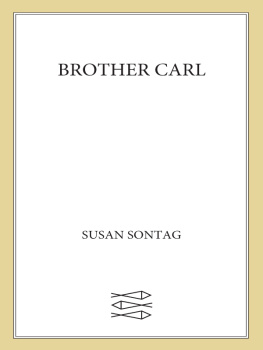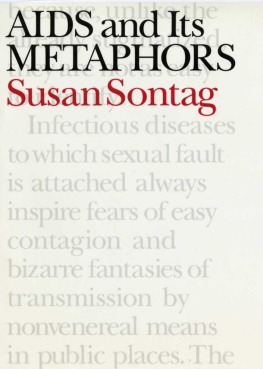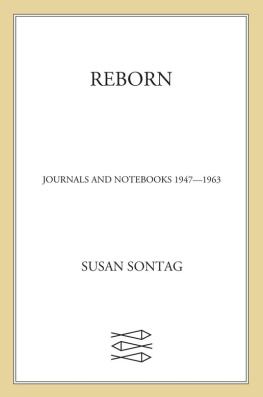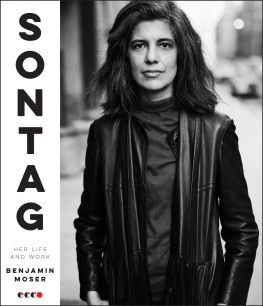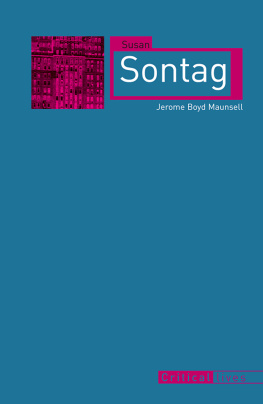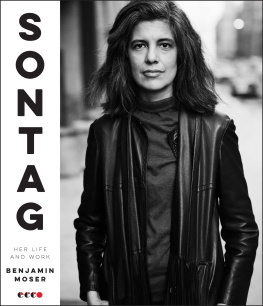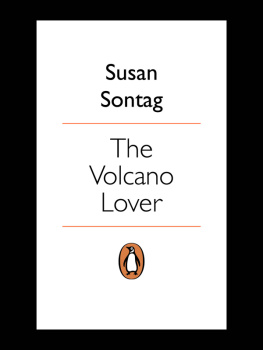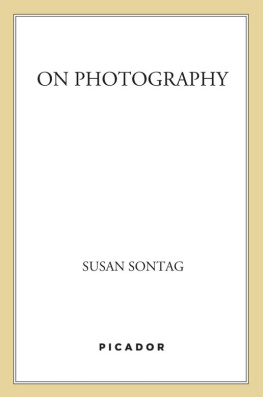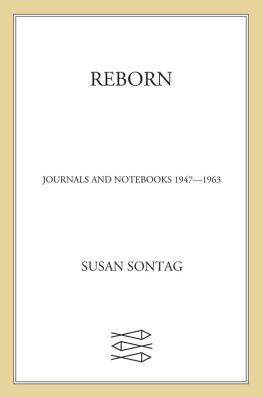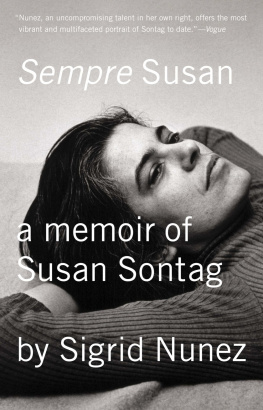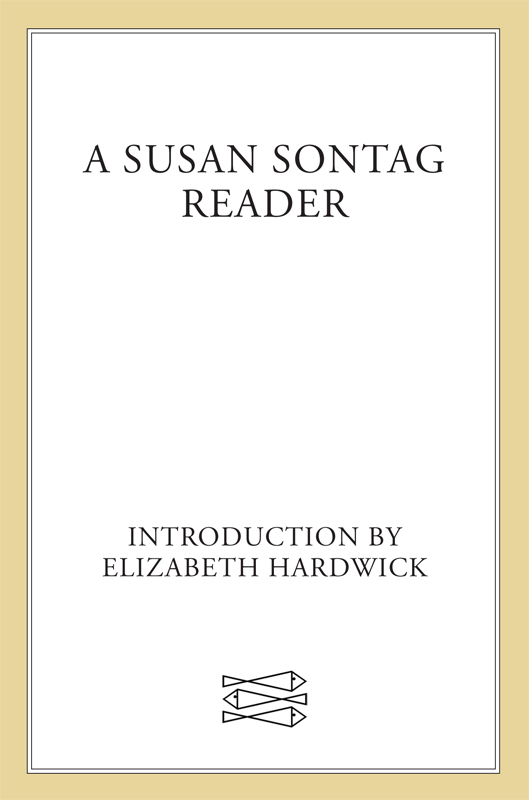Contents
Guide

The author and publisher have provided this e-book to you for your personal use only. You may not make this e-book publicly available in any way. Copyright infringement is against the law. If you believe the copy of this e-book you are reading infringes on the authors copyright, please notify the publisher at: us.macmillanusa.com/piracy.
Contents
FROM
The Benefactor
FROM
Against Interpretation
FROM
Death Kit
FROM
Styles of Radical Will
FROM
I, etcetera
FROM
Under the Sign of Saturn
FROM
On Photography
FROM
I, etcetera
FROM
Under the Sign of Saturn
appropriately, for Roger
Introduction
Essays lie all over the land, stored up like the unused wheat of a decade ago in the silos of old magazines and modest collections. In the midst of this clumsy abundance, there are rare lovers of the form, the great lovers being some few who practice it as the romance this dedication can be. And romance for us, the readers, when certain names appear on the cover of periodicals. Susan Sontag: the name is a resonance of qualities, of quality itself. The drama of the idea, the composition, a recognition from the past that tells us what the present may bestow when we see her name. The term essay itself is somewhat flat as a definition of the liberality of her floating, restless expositions. A Susan Sontag Reader, a choice from her criticism and fiction, is in no way scant, but it interested me to note that one could regret the omission of almost any piece of her writing, any square of the mosaic that is in the end an extraordinarily beautiful, expansive, and unique talent.
Her writings are hers, intimately and obsessively one might say. They bear, each one, the mark of a large and coherent sensibility, the mark of her interests, her sense of the aesthetic and moral world around us. Almost none of her work comes out of the mere occasion, the book published, the film released, or the fad acknowledged. I suppose her theme is the wide, elusive, variegated sensibility of modernisma reach of attitude and feeling that will include great works of art, the modern disturbance of the sense of self seen in camp and in pornography, and account for the social, historical disturbance represented by the contemporary glut of photographic images. Modernism is style and the large figures of culture she likes to reflect upon leave in their styles the signature of wishes, attractions, morals, and, always, ideas.
Susan Sontag is not drawn to her themes as a specialty, as one might choose the eighteenth century, but rather as expressions of her own taste, her own being, her own style perhaps. Her imagination is obstinate, stubborn in its insistence upon the heroic efforts of certain moving, complex modern princes of temperament such as Walter Benjamin, Artaud, Roland Barthes, Lvi-Strauss, Canetti, and the tragic moral philosopher Simone Weil. The modern sensibility in her view is democratic; it embraces the aristocratic spirit of the films made by Godard, Bresson, Bergman, and Syberberg. The listing of her interests shows an almost spendthrift openness to example and precept and vivacious practice. But her thoughts surprise. Films, writers, philosophers are, as it were, excavated, brought up to the topsoil to be viewed in the round. This is a particular vision, the defining glance of cultural history in which each thing is itself, unique and to some degree against interpretationand yet reflecting a disjunctive modern consciousness that is historical. On this theme and its fascinations each of her essays has a profound authority, a rather anxious and tender authoritythe reward of passion.
Writing Itself is the title of an essay on Roland Barthes. This essay, her last in point of sequence, is a complicated discourse that may be called formal in its inclusiveness. And yet in the purest sense it is a long, excited aside, free of pedantry, personal in its elevated attentiveness. It is an absorption, a saturation, indeed an infatuation arising from the mind laid bare in the writing, Barthess writing. There are his themes, his manner, and since no mind lives alone there are other philosophers, other writers, the period, and France itself. In the midst of all that, the style, the being who undertook his creative enterprises, cannot be understood apart from intuitions that see creation as a private destiny. This sense of the person is the text within the text in Susan Sontags essays; the man himself is a sort of interpolation to be arrived at by the critics imagination and feeling. She writes of Barthes: He speaks of the quiver, thrill, or shudder of meaning, and his intention is to give pleasure.
As I read over her work about figures from France and Germany, it occurs to me to remark what a good European is this completely American woman who grew up in Arizona and California, attended North Hollywood High, went to the University of Chicago and to Harvard. If I understand the phrase, to be a good European means to be international, respectful of the cultures and peculiarities of nations, to be rooted but not small or provincial or too native for curiosity. With Susan Sontag the ocean-spanning curiosity has been a kind of quest, an obligation to culture as well as the expression of a singular and brightly colored personality. The writers she has chosen to reflect upon are somewhat daunting and I do not think she would place herself among the undaunted. The tone of her writing is speculative, studious and yet undogmatic; even in the end it is still inquiring. There remains what Henry James called the soreness of confusion, the reminder of the unaccountable and inexhaustible in great talents. This remnant of wonder is her way of honoring the exceptional, the finally inimitable.
I do not wish to suggest too great a degree of the ambassadorial in her career, to make of a free and independent intelligence a bringer of news or even of the new. She is too much of a New Yorker for that, too much at home here where you cannot tell anyone anything. What I see as the urbanism of her spirit is the fluency that includes Paris, Berlin, and Rome, and thoughts about the fate of the photograph in Peking and curious aesthetics in Tokyo. She is patient about the mysteries of foreign cultures and patient with our own; her fluency extends to our streets with their pornography and politics, their theater and psychoanalysis. Style is everywhere; it is by patience and intuition that intentions are uncovered.
There is here the essay on style as an abstraction, on form and content as a question of philosophy and moral aesthetics. Whenever speech or movement or behavior or objects exhibit a certain deviation from the most direct, useful, insensible mode of expression or being in the world, we may look at them as having a style, and being both autonomous and exemplary. In my view, useful is the most interesting word here; to be beyond the useful and the necessary is to seek authenticity for the urgently invisible threads of cultural experience.
Style is to some degree a decision but it is most importantly a fate, growing out of the unconscious and exemplified, or partly exemplified, in the solutions of craft. This matter, style, which is always her theme, is the opposite of decoration and instead is a consuming essence from which morals, politics, vices, and virtues cannot be expunged. Style, often wishing to hide, is a constant exposure. The spiritual style of Robert Bressons films is cool, impersonal, and reserved; the fascist style of Leni Riefenstahl is dramatic, grandiose, orderly, communal, and tribal. Thus, you have not only creators and their achievement, you have character itself. The inner life revealed in style is quite apart from biography in the conventional sense, the biography of dates, ancestry, traumas, and endings. Although Susan Sontags work is rich in the sense of the artist as a living person, or as one who has lived, there is very little of the biographical.


